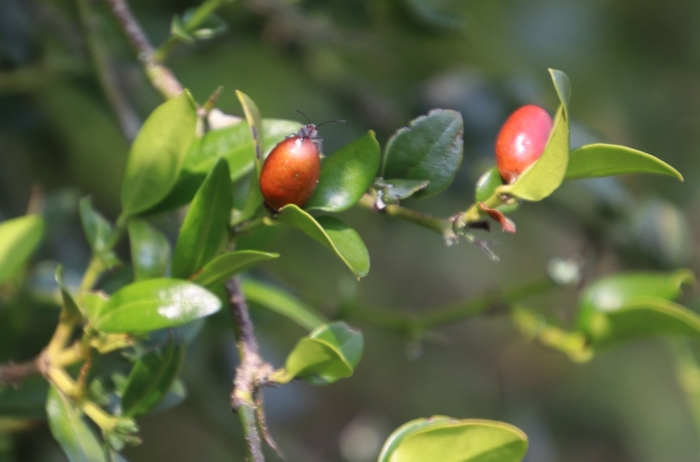Forest Num-Num
(Carissa bispinosa)
Forest Num-Num (Carissa bispinosa)
/
/

Tony Rebelo
CC BY-SA 4.0
Image By:
Tony Rebelo
Recorded By:
Copyright:
CC BY-SA 4.0
Copyright Notice:
Photo by: Tony Rebelo | License Type: CC BY-SA 4.0 | License URL: http://creativecommons.org/licenses/by-sa/4.0/ | Rights Holder: Tony Rebelo | Publisher: iNaturalist | Date Created: 2020-02-20T09:43:37-08:00 |



















Estimated Native Range
Summary
Carissa bispinosa, commonly known as Forest Num-Num or Y-Thorned Carissa, is an evergreen shrub or small tree native to a variety of habitats including coastal forests, bushveld, and riverine thickets from Uganda to South Africa. It typically grows up to 16 feet (5 meters) in height and features a dense, rounded to spreading form. The plant is adorned with fragrant white flowers that bloom sporadically throughout the year, with a peak in spring and summer. These blossoms are followed by attractive, round, red fruits that are edible when ripe and have a sweet taste.
Forest Num-Num is valued for its ornamental qualities, including its glossy, dark green leaves and the contrast between its fragrant white flowers and red fruit. It is often used in cultivation for hedges, screens, and as a security plant due to its thorny branches. It thrives in full sun to partial shade and prefers well-drained soils, tolerating a range of soil types. While it is drought-tolerant once established, moderate watering is recommended for optimal growth. Carissa bispinosa is also known for its low maintenance requirements and resilience to pests and diseases. However, it is potentially invasive in some regions outside its native range and should be planted with caution.CC BY-SA 4.0
Forest Num-Num is valued for its ornamental qualities, including its glossy, dark green leaves and the contrast between its fragrant white flowers and red fruit. It is often used in cultivation for hedges, screens, and as a security plant due to its thorny branches. It thrives in full sun to partial shade and prefers well-drained soils, tolerating a range of soil types. While it is drought-tolerant once established, moderate watering is recommended for optimal growth. Carissa bispinosa is also known for its low maintenance requirements and resilience to pests and diseases. However, it is potentially invasive in some regions outside its native range and should be planted with caution.CC BY-SA 4.0
Plant Description
- Plant Type: Shrub, Tree
- Height: 4-6 feet
- Width: 4-6 feet
- Growth Rate: Moderate
- Flower Color: White
- Flowering Season: Spring, Summer
- Leaf Retention: Evergreen
Growth Requirements
- Sun: Full Sun, Part Shade
- Water: Medium, High
- Drainage: Medium, Fast
Common Uses
Bird Garden, Drought Tolerant, Edible*Disclaimer: Easyscape's listed plant edibility is for informational use. Always verify the safety and proper identification of any plant before consumption., Fragrant, Hedges, Low Maintenance, Showy Flowers
Natural Habitat
Native to coastal forests, bushveld, and riverine thickets from Uganda to South Africa
Other Names
Common Names: Natal Plum, Amatungulu, Forest Num-Num, Fork-Spined Carissa, Karoo Num-Num
Scientific Names: , Carissa bispinosa, Arduina acuminata, Arduina bispinosa, Arduina erythrocarpa, Arduina megaphylla, Carandas arduina, Carissa acuminata, Carissa arduina, Carissa bispinosa subsp. zambesiensis
GBIF Accepted Name: